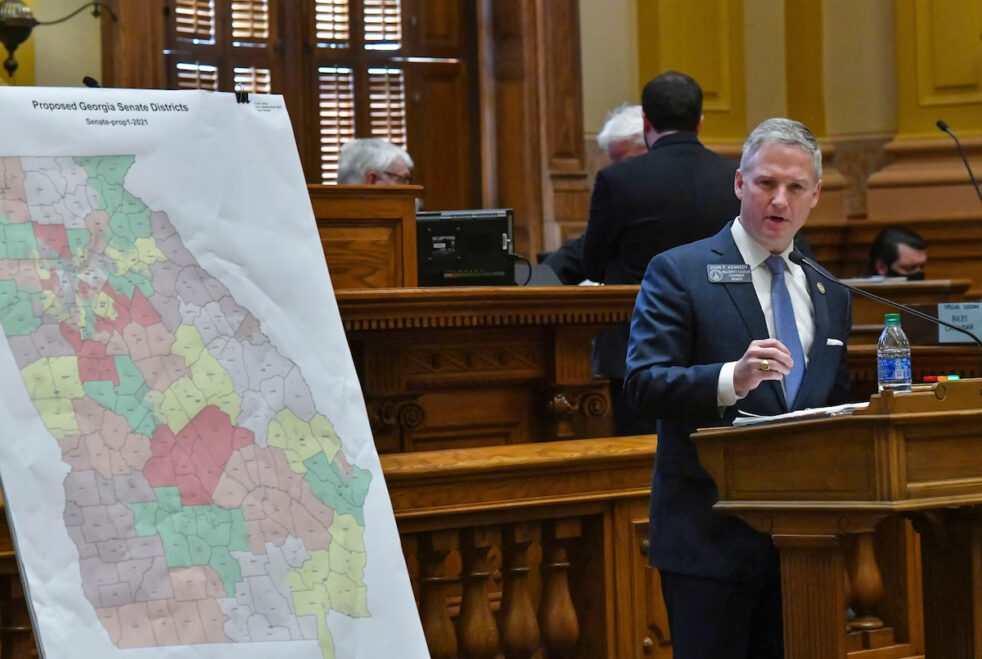On Thursday, Oct. 26, Judge Steve Jones, U.S. District Court Judge for the Northern District of Georgia, ruled that certain Georgia congressional districts had been drawn unlawfully. In a 516-page order following an eight-day trial last month, Judge Jones deemed the Republican majority-drawn maps as racially discriminatory and in violation of Section 2 of the Voting Rights Act of 1965. He further detailed a remedy involving an added Black-majority congressional district in west-metro Atlanta, two added Black-majority senate districts in south-metro Atlanta, two added Black-majority house districts in south-metro Atlanta, one added Black-majority house districts in west-metro Atlanta and two added Black-majority house districts in and around Macon-Bibb County, Georgia, among other ordinances.
Georgia Gov. Brian Kemp has called for a special session on Nov. 29 to revise the political maps, as Jones ordered the General Assembly to take action by Oct. 8 and stated that under the current maps, the 2024 elections can not go forward. The plaintiffs argued that without federal support, Black voters would be unable to fight voter disenfranchisement; meanwhile, the state argued that court intervention for Black voting is unnecessary.
This issue has persisted since the 2020 census demonstrated a notable growth in diversity within the state. The plaintiffs contended that the census indicated tremendous growth in the Black population especially. However, the districts did not reflect this trend, suggesting a dilution of Black voter strength in areas such as metro Atlanta, where Black populations have increased by hundreds of thousands, according to the American Civil Liberties Union.
“The Georgia legislature, and I should say the majority party in the Georgia legislature, draws political maps…how those maps are drawn is incredibly important, because depending on what neighborhoods and populations you put in a certain district, a district tends to vote a certain way, or could tend to vote a certain way. And while the citizenry may want competitive districts, there’s a lot of incentive for politicians who have to run for office to pick districts less competitive,” said Democratic Georgia State House Representative and civil
rights attorney Saira Draper.
Political district maps are redrawn every 10 years, and under the Voting Rights Act, partisan gerrymandering is legal — racial gerrymandering is not. Parsing this legal fine line has become more of an issue following the United States Supreme Court’s removal of a preclearance requirement in the 2013 case, Shelby County v. Holder. Preclearance required Georgia to clear its voting law changes with the federal government before making changes to the official procedures. At present, under the Republican trifecta — a GOP-majority state house, senate and governor — legislators are able to implement changes without prior notice to the federal government and without Democratic support.
“New maps will go through the traditional legislative process. Legislation will have to be introduced and assigned to committee. It will have to pass committee, Rules, and the House Floor. It will go through the same process on the Senate side before it is signed by the Governor like any other piece of legislation,” said Democratic House Representative Samuel Park when asked about the path new maps will follow.
State House and Senate Republicans have called for an appeal following the ruling, a fully legal option for Republican lawmakers. However, Republican Speaker of the Georgia House Jon Burns has maintained that they will adhere to the court’s order. Little is known regarding what the new maps will look like outside of Judge Jones’ detailed requirements; there exists the possibility that some legislators may even be zoned out of their own districts. This has occurred in the past, such as with the implementation of a new Georgia political map in 2021. This map rezoned United States Representative Lucy McBath, who jumped from Georgia’s sixth district, which she had won after decades of GOP control, to the seventh, which housed an incumbent Democrat. Democrats have tried to propose an even split between the 14 Georgia congressional districts, while certain nonpartisan organizations, such as Fair Districts Georgia, have argued that an eight-to-six split would be most reflective of Georgia’s current political climate.
“There are people that have a problem with politicians being the ones to draw the boundary, because, of course, we have a very clear conflict of interest. In other states, they have what we call independent redistricting commissions that consist of people who are not elected and that don’t have that same conflict of interest, who draw the maps,” said Representative Draper.
The new Republican-drawn maps will be released to the public in the next few weeks. Democrats may finally receive the opportunity to collect more seats in the Georgia General Assembly and even compete to curb the power of the Republican trifecta. However, the significance of this redistricting session lies in the possibility of increasing competitiveness in each district.
As Georgians wait to see how the mandated revisions will affect their districts, Representative Draper emphasizes the importance of bipartisan compromise in redrawing the districts.
She said, “Certainly there will be committee hearings on these maps; I hope that we’ll have lots of robust discussion…I hope there will be discussion with Democrats about boundaries, I don’t know that there will be, we’re still waiting on word. So basically, you know, they hold the pen, they can do these things, or they don’t have to do these things. And we will find out soon enough what they decide to do.”
